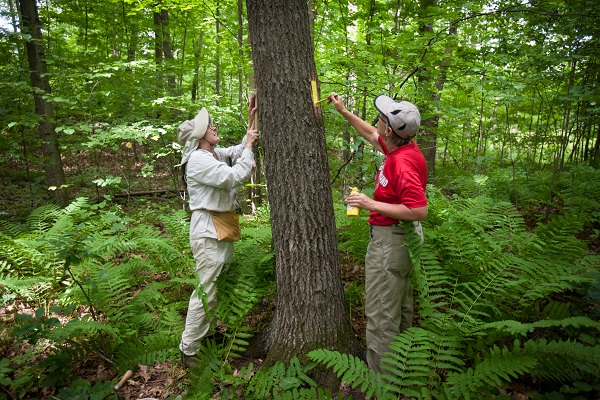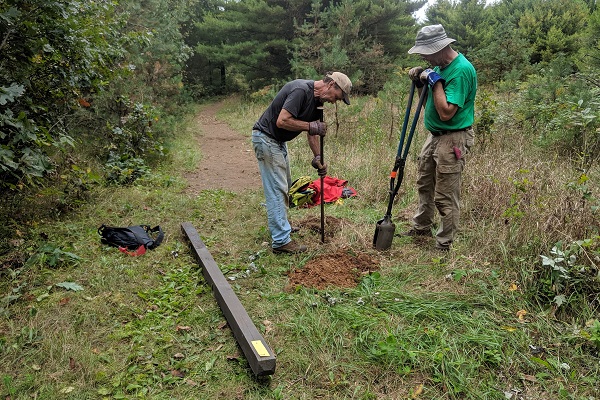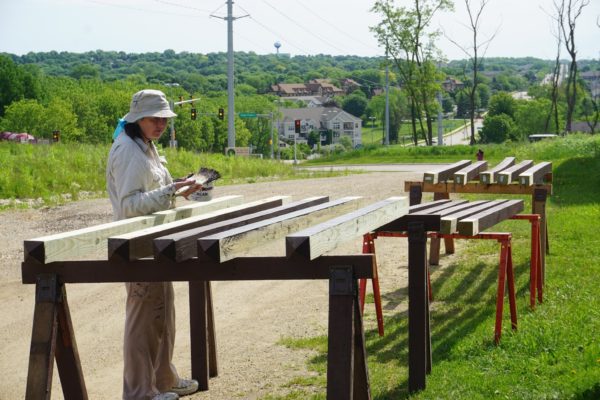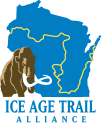By Christi Lee Ehler, Volunteer Writer for the Ice Age Trail Alliance

Ice Age National Scenic Trail users are human — and unfortunately our ingrained negativity bias ensures a particular kind of reactivity to trail conditions: This sock-snagging span of brambles sure is annoying! Yet maybe you’re inclined to take for granted the previous and subsequent miles of bramble-free trail?
Expert Ice Age Trail (IAT) maintenance and stewardship has a quality of invisibility that allows hikers and runners to relish their aesthetic experience rather than constantly watching their feet. That stunning river view? It’s been kept open by regular brush trimming. That forest floor carpeted with blossoming native Bloodroot? It’s the result of a labor of love, not a happy accident.
Year-round, day-to-day Trail care is accomplished by a multitude of volunteers who belong to one of the Ice Age Trail Alliance’s (IATA) 19 volunteer chapters along the IAT’s 1,200-mile length. Volunteer hours, annually logged for maintenance and stewardship, number from many hundreds to several thousand per chapter. (Not including volunteer hours devoted to outreach activities like guided hikes or educational programs).
In 2019, 2,376 IATA volunteers contributed 82,880 hours of service on behalf of the Trail.

Reconnecting with the Trail
The COVID-19 pandemic and related Safer-At-Home order in March of 2020 threw a monkey wrench into the regular trail maintenance activity calendars of local chapters statewide. In compliance with National Park Service guidelines, the IATA called a halt to all outdoor volunteer activities, thereby delaying routine spring tasks such as mowing, prairie burning, refreshing blazes, and otherwise addressing the typical ravages of a Wisconsin winter. At the same time, the situation drew record numbers of users onto the Trail who might otherwise seek exercise at a gym or through team sports. IATA volunteers were charged with assessing Trail needs but not acting to remedy them until given a go-ahead under a future IATA Trail Reconnect Plan.
In some areas, trampling feet accomplished what mowing machines could not, keeping grass down. In other areas, increased foot traffic hastened the demise of aging structures, threatened sensitive vegetation, or exacerbated erosion. Overall, the Trail proved to stand up well to the “extra hammering”, a testament to the high standards to which it was built. Nonetheless, as restrictions on volunteer activities were lifted on May 24, 2020, chapters now find themselves with an ever-growing list of catch-up tasks to undertake.

Volunteer Chapters: Coordinating Efforts Across the State
Without exception, every chapter relies on a core group of passionately devoted volunteers who take pride in making the IAT both safe and pleasant to use. In smaller chapters, one main Chapter Coordinator may manage outreach as well as maintenance and stewardship. Larger chapters support multiple coordinator roles for various aspects of trail work.
Mid-size chapters like Chippewa Moraines and Waushara County have designated Trail Maintenance Coordinators who supervise crews of up to 20 volunteers on an average monthly workday. Dane County has separate coordinators for Trail Maintenance and Trail Stewardship and holds one or more workdays almost every weekend throughout the year.
In northern counties, far from any large urban center, the Blue Hills and High Point chapters draw on a much smaller pool of volunteers. Yet their trail work season is short and intense due to long winters, deep snows, and prolonged wet conditions in spring. They schedule less frequent regular workdays, tackling downed trees and other problems as they arise along dozens of the most remote-access miles of the IAT.
Many chapters incorporate some form of trail adopter system. Variously referred to as “trail monitors”, “section maintainers” or similar terms, adopters commit to stewarding a given section of trail on a regular basis. Depending on the chapter, tasks may include vegetation control, monitoring blaze visibility, removing litter, reporting larger problem areas, and serving as a general trail ambassador. Indianhead Chapter’s Adopt-a-Trail Coordinator manages about 50 volunteers who undertake responsibility for 36 trail sections of varying lengths and differing maintenance needs.
Some chapters face other challenges related to local geography, as with the Baraboo/Heritage Chapter. “We’re competing with a lot of other natural wonders in the area for volunteer interest,” their Coordinator says. The Devil’s Lake Segment sees millions of visitors each year, but few of those live close enough to become regular volunteers.
See the full list of chapters by clicking here.

In deciding where to concentrate attention, leaders make personal observations about trail conditions and often receive information from hikers. They also take project recommendations from IATA staff and collaborate with state and national forests, state and county parks, and land conservancies through which the IAT passes. Typical “trail improvement” tasks range from corridor clearing, tread grooming, and structure repair to larger projects like boardwalk builds and trail reroutes. Most chapters publish “Trail Improvement Days” through social media, email, newsletters and/or the IATA Events Calendar.
This summer, under the Alliance’s Reconnect with the Trail effort, numerous chapter trail improvement event listings will be noted as a “Reconnect” event.
Trail improvement days are open to both seasoned and new volunteers. Chapters frequently coordinate with local businesses, churches, schools, and organizations serving at-risk youth to provide volunteer opportunities for community members. Chapter leaders strive to match volunteers’ strengths and interests to chapter needs and abide by the IATA philosophy that trail work should be both safe and fun.

Not all IAT volunteer work requires you to brave the elements or get dirt under your fingernails. Every chapter welcomes volunteers with leadership and organizational skills, communication skills, mechanical or carpentry know-how, or ability to manage collaborative relationships with other trail user groups from bicyclists to snowmobilers to equestrians. (Not to mention a few cookie-bakers.) As older volunteers step down, there’s always a need for new volunteers to step up.
If you ask a lopper-wielding volunteer how they got involved with the IAT, many will speak in terms of wanting to “give back to the Trail”. They may note, “The Trail was there for me when I needed it.” Thanks to the ongoing dedication of countless volunteers since the IAT came into existence over 60 years ago, the Trail will continue to be there for all who need it.
Want to join volunteering efforts along the Ice Age Trail? Connect with a Volunteer Chapter near you!
About the Author
Christi enjoys spending as much time as possible outdoors. While hiking in a county park one autumn day, an encounter with a group of volunteers engaged in trail stewardship prompted an epiphany that led her to join a Mobile Skills Crew project in 2015. That event marked the beginning of a growing passion for trail building with the IATA. Writing about trail work is icing on the cake.

